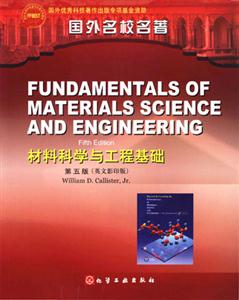掃一掃
關(guān)注中圖網(wǎng)
官方微博
本類五星書更多>
-
>
公路車寶典(ZINN的公路車維修與保養(yǎng)秘籍)
-
>
晶體管電路設(shè)計(下)
-
>
基于個性化設(shè)計策略的智能交通系統(tǒng)關(guān)鍵技術(shù)
-
>
花樣百出:貴州少數(shù)民族圖案填色
-
>
山東教育出版社有限公司技術(shù)轉(zhuǎn)移與技術(shù)創(chuàng)新歷史叢書中國高等技術(shù)教育的蘇化(1949—1961)以北京地區(qū)為中心
-
>
鐵路機(jī)車概要.交流傳動內(nèi)燃.電力機(jī)車
-
>
利維坦的道德困境:早期現(xiàn)代政治哲學(xué)的問題與脈絡(luò)
材料科學(xué)與工程基礎(chǔ)(第五版)(英文影印版) 版權(quán)信息
- ISBN:7502541780
- 條形碼:9787502541781 ; 978-7-5025-4178-1
- 裝幀:簡裝本
- 冊數(shù):暫無
- 重量:暫無
- 所屬分類:>
材料科學(xué)與工程基礎(chǔ)(第五版)(英文影印版) 內(nèi)容簡介
該書具有很完整的材料與工程體系,無論作為材料專業(yè)的教材,還是科技書,都具有很強(qiáng)的實用價值。
材料科學(xué)與工程基礎(chǔ)(第五版)(英文影印版) 目錄
1. Introduction
1.1 Historical Perspective
1.2 Materials Science and Engineering
1.3 Why Study Materials Science and Engineering?
1.4 Classification of Materials
1.5 Advanced Materials
1.6 Modern Materials’Needs
2.Atomic Structure and Interatomic Bonding
2.1 Introduction
2.2 Fundamental Concepts
2.3 Electrons in Atoms
2.4 The Periodic Table
2.5 Bonding Forces and Energies
2.6 Primary Interatomic Bonds
2.7 Secondary Bonding or Van der Waals Bonding
2.8 Molecules
3. Structures of Metals and Ceramics
3.1 Introduction
3.2 Fundamental
3.3 Unit Cells
3.4 Metallic Crystal Structures
3.5 Density Computations-Metals
3.6 Ceramic Crystal Structures
3.7 Density Computations-Ceramics
3.8 Silicate Ceramics
3.9 Carbon
3.10 Polymorphism and Allotropy
3.11 Crystal Systems
3.12 Crystallographic Directions
3.13 Crystallographic Planes
3.14 Linear and Planar Atomic Densities
3.15 Close-Packed Crystal Structures
3.16 Single Crystals
3.17 Polycrystalline Materials
3.18 Anisotropy
3.19 X-Ray Diffraction:Determination of Crystal Structures(CD-ROM)S-6
3.20 Noncrystalline solids
4. Polymer Strutures
4.1 Introduction
4.2 Hydrocarbon Molecules
4.3 Polymer Molecules
4.4 The Chemistry of Polymer Molecules
4.5 Molecular Weight
4.6 Molecular Shape
4.7 Molecular Structure
4.8 Molecular Configurations(CD-ROM)S-11
4.9 Thermoplastic and Thermosetting Polymers
4.10 Copolymers
4.11 Polymer Crystals
4.12 Polymer Crystals
5.Imperfections in Solids
5.1 Introduction
5.2 Point Defects in Metals
5.3 Point Defects in Ceramics
5.4 Impurities in Solids
5.5 Point Defects in Polymers
5.6 Specification of Composition
5.7 Dislocations-Linear Defects
5.8 Interfacial Defects
5.9 Bulk or Volume Defects
5.10 Atomic Vibrations
5.11 General
5.12 Microscopic Techniques
5.13 Grain Size Determination
6.Diffusion
6.1 Introduction
6.2 Diffusion Mechanisms
6.3 Steady-State Diffusion
6.4 Nonsteady-State Diffusion
6.5 Factors That Influence Diffusion
6.6 Other Diffusion Paths
6.7 Diffusion in Ionic and Polymeric Materials
7.Mechanical Properties
7.1 Introduction
7.2 Concepts of Stress and Strain
7.3 Stress-Strain Behavior
7.4 Anelasticity
7.5 Elastic Properties of Materials
7.6 Tensile Properties
7.7 True Stress and Strain
7.8 Elastic Recovery During Plastic Deformation
7.9 Compressive,Shear,and Torsional Deformation
7.10 Flexural Strength
7.11 Elastic Behavior
7.12 Influence of Porosity on the Mechanical Propertise of Ceramics(CD-ROM)S-22
7.13 Stress-Strain Behavior
7.14 Macroscopic Deformation
7.15 Viscoelasticity(CD-ROM)S-22
7.16 Hardness
7.17 Hardness of Ceramic Materials
7.18 Tear Strength and Hardness of Polymers
7.19 Variability of Material Properties
7.20 Design/Safety Factors
8.Deformation and Strengthening Mechanisms
8.1 Introduction
8.2 Historical
8.3 Basic Concepts of Dislocations
8.4 Characteristics of Dislocations
8.5 Slip Systems
8.6 Slip in Single Crystals(CD-ROM)S-31
8.7 Plastic Deformation of Polycrystalline Metals
8.8 Deformation by Twinning(CD-ROM)S-34
8.9 Strengthening by Grain Size Reduction
8.10 Solid-Solution Strengthening
8.12 Recovery
8.13 Recrystallization
8.14 Grain Growth
8.15 Crystalline Ceramics
8.16 Noncrystalline Ceramics
8.17 Deformation of Semicrystalline Polymers
8.18 Factors That Influence the Mechanical Properties of Semicrystalline Polymers[Detailed Version (CD-ROM)]S-35
8.19 Deformation of Elastomers
9.Failure
9.1 Introduction
9.2 Fundamentals of Fracture
9.3 Ductile Fracture
9.4 Brittle Fr
1.1 Historical Perspective
1.2 Materials Science and Engineering
1.3 Why Study Materials Science and Engineering?
1.4 Classification of Materials
1.5 Advanced Materials
1.6 Modern Materials’Needs
2.Atomic Structure and Interatomic Bonding
2.1 Introduction
2.2 Fundamental Concepts
2.3 Electrons in Atoms
2.4 The Periodic Table
2.5 Bonding Forces and Energies
2.6 Primary Interatomic Bonds
2.7 Secondary Bonding or Van der Waals Bonding
2.8 Molecules
3. Structures of Metals and Ceramics
3.1 Introduction
3.2 Fundamental
3.3 Unit Cells
3.4 Metallic Crystal Structures
3.5 Density Computations-Metals
3.6 Ceramic Crystal Structures
3.7 Density Computations-Ceramics
3.8 Silicate Ceramics
3.9 Carbon
3.10 Polymorphism and Allotropy
3.11 Crystal Systems
3.12 Crystallographic Directions
3.13 Crystallographic Planes
3.14 Linear and Planar Atomic Densities
3.15 Close-Packed Crystal Structures
3.16 Single Crystals
3.17 Polycrystalline Materials
3.18 Anisotropy
3.19 X-Ray Diffraction:Determination of Crystal Structures(CD-ROM)S-6
3.20 Noncrystalline solids
4. Polymer Strutures
4.1 Introduction
4.2 Hydrocarbon Molecules
4.3 Polymer Molecules
4.4 The Chemistry of Polymer Molecules
4.5 Molecular Weight
4.6 Molecular Shape
4.7 Molecular Structure
4.8 Molecular Configurations(CD-ROM)S-11
4.9 Thermoplastic and Thermosetting Polymers
4.10 Copolymers
4.11 Polymer Crystals
4.12 Polymer Crystals
5.Imperfections in Solids
5.1 Introduction
5.2 Point Defects in Metals
5.3 Point Defects in Ceramics
5.4 Impurities in Solids
5.5 Point Defects in Polymers
5.6 Specification of Composition
5.7 Dislocations-Linear Defects
5.8 Interfacial Defects
5.9 Bulk or Volume Defects
5.10 Atomic Vibrations
5.11 General
5.12 Microscopic Techniques
5.13 Grain Size Determination
6.Diffusion
6.1 Introduction
6.2 Diffusion Mechanisms
6.3 Steady-State Diffusion
6.4 Nonsteady-State Diffusion
6.5 Factors That Influence Diffusion
6.6 Other Diffusion Paths
6.7 Diffusion in Ionic and Polymeric Materials
7.Mechanical Properties
7.1 Introduction
7.2 Concepts of Stress and Strain
7.3 Stress-Strain Behavior
7.4 Anelasticity
7.5 Elastic Properties of Materials
7.6 Tensile Properties
7.7 True Stress and Strain
7.8 Elastic Recovery During Plastic Deformation
7.9 Compressive,Shear,and Torsional Deformation
7.10 Flexural Strength
7.11 Elastic Behavior
7.12 Influence of Porosity on the Mechanical Propertise of Ceramics(CD-ROM)S-22
7.13 Stress-Strain Behavior
7.14 Macroscopic Deformation
7.15 Viscoelasticity(CD-ROM)S-22
7.16 Hardness
7.17 Hardness of Ceramic Materials
7.18 Tear Strength and Hardness of Polymers
7.19 Variability of Material Properties
7.20 Design/Safety Factors
8.Deformation and Strengthening Mechanisms
8.1 Introduction
8.2 Historical
8.3 Basic Concepts of Dislocations
8.4 Characteristics of Dislocations
8.5 Slip Systems
8.6 Slip in Single Crystals(CD-ROM)S-31
8.7 Plastic Deformation of Polycrystalline Metals
8.8 Deformation by Twinning(CD-ROM)S-34
8.9 Strengthening by Grain Size Reduction
8.10 Solid-Solution Strengthening
8.12 Recovery
8.13 Recrystallization
8.14 Grain Growth
8.15 Crystalline Ceramics
8.16 Noncrystalline Ceramics
8.17 Deformation of Semicrystalline Polymers
8.18 Factors That Influence the Mechanical Properties of Semicrystalline Polymers[Detailed Version (CD-ROM)]S-35
8.19 Deformation of Elastomers
9.Failure
9.1 Introduction
9.2 Fundamentals of Fracture
9.3 Ductile Fracture
9.4 Brittle Fr
展開全部
書友推薦
- >
上帝之肋:男人的真實旅程
- >
二體千字文
- >
唐代進(jìn)士錄
- >
羅庸西南聯(lián)大授課錄
- >
名家?guī)阕x魯迅:朝花夕拾
- >
姑媽的寶刀
- >
我與地壇
- >
莉莉和章魚
本類暢銷

















